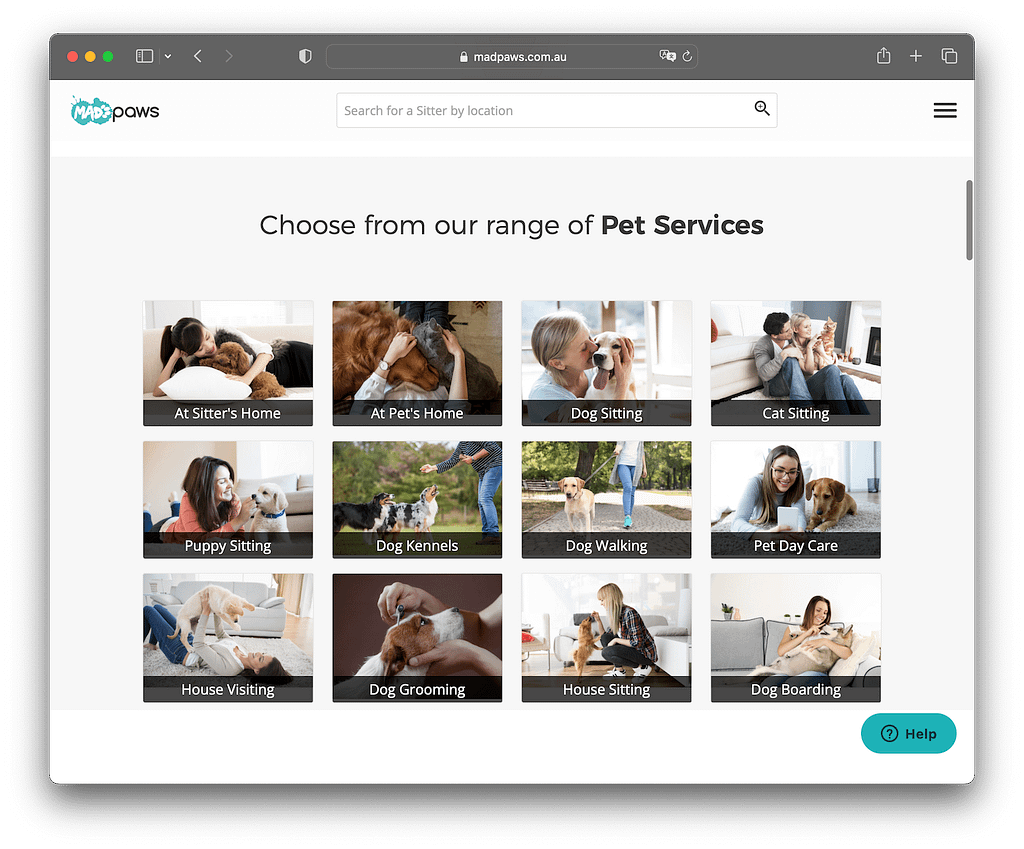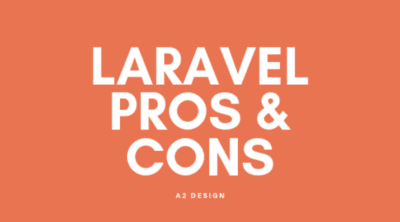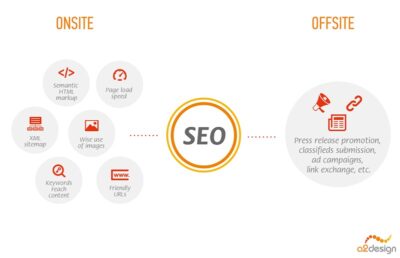15 Proven Strategies to Attract Your First Marketplace Users

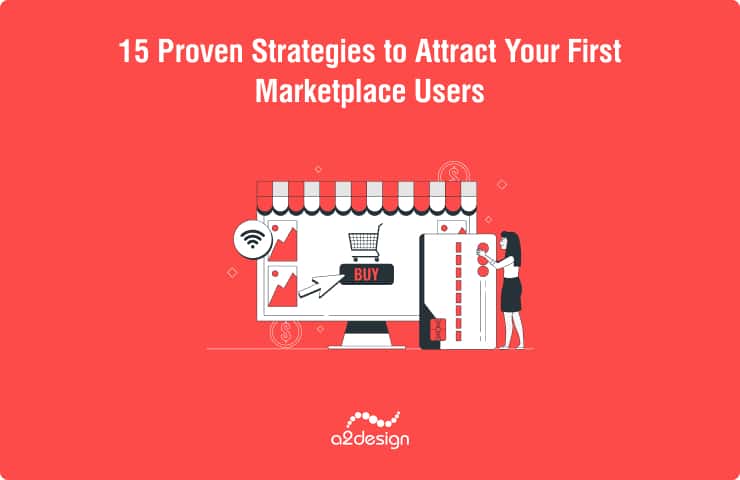
Think about Uber changing how we catch a ride, Etsy letting crafters sell worldwide, or Airbnb opening up a new kind of travel. Marketplaces are everywhere, and they’ve changed how we buy, sell, and connect. The best ones feel like magic!
But building a marketplace from the ground up? That’s where things get challenging. Imagine throwing a party, and nobody shows up. That’s the feeling of launching a marketplace without any users. Attracting those critical first users, the ones who will try something new and help your marketplace take flight requires a strategic approach.
Don’t worry. This article is here to help.
In this article, you’ll learn 15 of the most effective strategies for building a successful online marketplace. We’ll equip you with actionable strategies to find your ideal users, build a thriving community around your marketplace, and keep them returning for more. It won’t be a walk in the park, but with the right plan and execution, it’s absolutely achievable. The strategies covered here including:
- Learn how to figure out who your perfect early users are
- Find out where those users hang out online (and how to blend in!)
- Get tips for keeping your early users happy and coming back
- Choosing the right niche for your marketplace
- Targeted ads and other marketing tactics
By the end of this article, you’ll have a more solid foundation for building a successful marketplace and attracting enough users to it.
Ready to start building a strong foundation for your marketplace? Let’s dive into this guide right away.
Building a Foundation for Your MarketplaceThis first group of strategies is about building a solid foundation for your marketplace to achieve success.
Think of your marketplace like a house. You need a solid foundation before you put up the walls and make things pretty.
Let’s get started.
Strategy 1: Define Your Ideal Users

Imagine you’re opening a restaurant. Do you want to serve fancy dinners to wealthy people or quick and tasty lunches to busy office workers? You need to know your customers before you start designing the menu! It’s the same with a marketplace. To get the right folks to join, you need to get inside their heads and truly understand them. This means digging deeper beyond basic demographics and into what makes your target audience tick.
Here are the key areas to focus on:
- Demographics: This is the foundation of your user profile. It includes things like age, gender, location, education level, income level, and even family situation. Demographic information helps you understand who you’re reaching and where to find them. Are you targeting young tech enthusiasts or maybe retired folks with a passion for antiques? Demographics help paint a broad picture of your ideal users.
- Pain Points: What problems are your users facing that your marketplace can solve? Are they tired of overpriced items at traditional stores? Maybe they’re frustrated with the hassle of selling unwanted belongings through yard sales or classifieds. Do they crave a more personalized shopping experience or a way to connect with people who share their interests? Understanding these pain points is crucial. When you can clearly see what’s frustrating your target users, you can design your marketplace as a solution to those problems.
- Motivations: What makes your ideal users tick? What drives them to buy or sell on your platform? Are they motivated by finding the best deals? Maybe they value convenience and a seamless shopping experience. Perhaps they enjoy the thrill of discovering unique items or the satisfaction of decluttering their homes and making some extra cash. Understanding their motivations allows you to tailor your marketplace experience to resonate with their desires.
Digging Even Deeper: Psychographics
Demographics and pain points are a great starting point, but to get a truly well-rounded picture of your ideal user, you should also consider psychographic.
“Psychographic” refers to the personality traits, interests, values, and lifestyles of your target audience. Here are some ways to think about psychographics for your marketplace:
- Interests: What are your users passionate about? Do they love spending hours reading novels, playing video games, or are they more into healthy living? Understanding their interests allows you to craft a more targeted marketplace design. Imagine a platform for used video games that also features articles and forums for gamers to connect and discuss their favorite titles.
- Values: What’s important to your target audience? Are they environmentally conscious and looking for sustainable products? Maybe they prioritize quality and craftsmanship over getting the cheapest deal. Understanding their values allows you to position your marketplace to align with these values.
- Lifestyles: How do your users live their lives? Are they busy professionals with limited free time, or stay-at-home parents with more flexibility? Understanding their lifestyles helps you tailor the user experience to fit their needs. Maybe your marketplace offers a mobile app for on-the-go shopping, or perhaps it features a robust messaging system to facilitate communication between buyers and sellers.
By considering both demographics and psychographics, you can create a rich and detailed profile of your ideal user. This user persona will be your guiding light as you design and develop your marketplace, ensuring every feature and function caters to the specific needs and desires of the people you want to attract.
Strategy 2: Early User Acquisition Tactics
Okay, you know WHO you want on your marketplace. But why should they bother signing up when there are other options out there? You need something that makes your marketplace stand out from the crowd. That’s your value proposition.
Think about it like this: You’re at the grocery store, and there are three different boxes of cereal. How do you decide? Price? Cool-looking mascot? Maybe if one promises healthier ingredients. Your value proposition is like those selling points – it’s what makes someone pick YOUR marketplace over the competition.
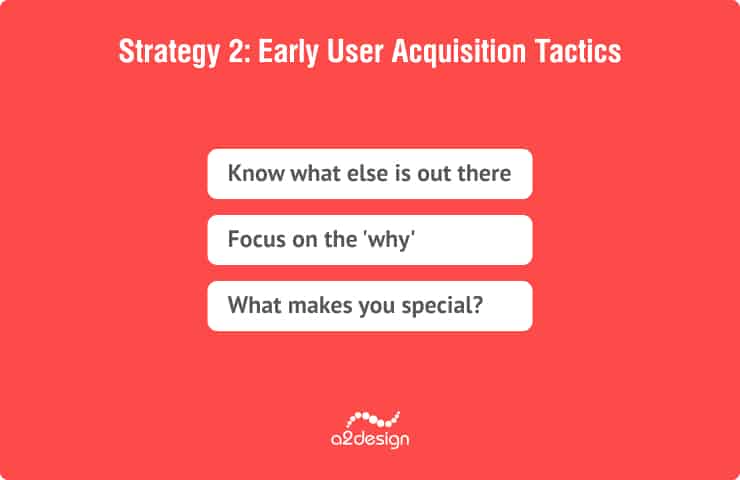
Here’s how to make yours awesome:
- Know What Else is Out There: Don’t build your marketplace in a bubble! Figure out who you’re competing against, even if it’s only indirectly. Are there big-name marketplaces everyone uses? What about smaller, niche ones? Take a good look at their strengths and their weaknesses – this is your chance to do better!
- Focus on the ‘Why’: Don’t just list features like “easy to use” or “secure payments”. That’s boring! Instead, think about how those features benefit the user. Does “easy to use” mean buyers can find what they need fast? Do “secure payments” give sellers peace of mind? Tie your features to real-world benefits that show you understand what your users want.
- What Makes You Special?: No marketplace can do everything perfectly. It’s more important to do a few things really well. So, what’s your thing? Maybe you offer the absolute lowest fees, or the most carefully curated selection, or maybe community features that help buyers and sellers connect in a way no one else does. Own it!
Where A2 Design Can Help
Looks matter. A lot. Your marketplace needs to look great and be easy to use so people enjoy their experience. That’s where A2 Design’s expertise in UI/UX design comes in. They can help you create a beautiful and intuitive marketplace that makes your value proposition shine bright. After all, who wants to shop somewhere that looks like it was made in the 90s?
Strategy 3: Nail Your Niche
Imagine trying to sell every type of food in a single store. It’d be chaos! You’d have fresh produce next to frozen pizzas, candy, snacks, everything. Who’s going to shop there? No one’s going to find what they need easily, and it all feels a bit random. Marketplaces work the same way.

Instead of trying to be everything to everyone, start by focusing on a smaller, specific niche. Here’s why that’s a smart move:
- Enhanced Visibility: In a crowded marketplace landscape, catering to a well-defined niche allows you to differentiate your offering and become the go-to destination for a specific audience. For example, a marketplace specializing in handcrafted jewelry is more likely to stand out to dedicated jewelry enthusiasts than a generic e-commerce platform.
- Optimized User Experience: Specializing in a specific niche allows you to better grasp your customers’ needs and pain points. Doing so enables you to design features, content, and search functionalities that answer your users’ specific needs. Ultimately, this will result in a more optimal and seamless user experience.
- Targeted Marketing: By targeting a specific niche, you can personalize your marketing messages and outreach channels specifically to your target demographic. A more focused strategy won’t only help attract potential consumers to your platform. Yet, it will also help you minimize acquisition costs and boost efficiency.
Balancing Specialization:
While the value of niche focus is clear, it’s important to strike a balance. An overly narrow niche risks limiting your potential audience and hindering long-term growth prospects. Carefully assess the size and potential of your chosen niche to ensure it can sustain a thriving marketplace.
A successful niche-focused marketplace can provide valuable insights to guide future expansion. By closely monitoring user behavior and feedback, you can identify opportunities to broaden your offerings into adjacent or complementary niches, achieving sustainable growth while maintaining your core identity.
Early User Acquisition TacticsThis next group of tips will cover strategies you can use during the early user acquisition stage. These strategies will include how to tap into existing communities, leverage influencer marketing, and run effective promotional ads.
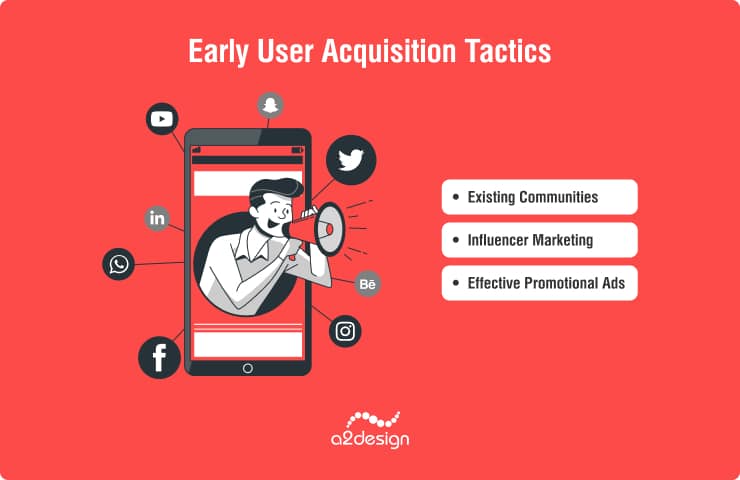
Strategy 4: Tapping into Existing Communities
Your ideal users are already hanging out somewhere on the internet. You just need to find out where the right folks are chatting, sharing tips, and asking questions. Here are some ideas of where you should look for them:
- Forums: Are there niche forums dedicated to whatever your marketplace is about? Think of old-school message boards where people post threads and have discussions. These can be goldmines for finding passionate people interested in your niche.
- Social Media Groups: Facebook Groups, LinkedIn Groups, and even smaller platforms might have active communities related to your marketplace’s focus. For example, if you’re focused on sustainable fashion, look for groups about secondhand clothing or ethical shopping.
- Subreddits: Reddit has a subreddit for basically every interest imaginable. These are sometimes a little wilder than regular forums, but there’s tons of activity. Search for relevant keywords related to your niche and see what comes up.
- Industry Associations: Depending on your niche, there might be industry groups or associations that have online communities or forums. These tend to have more professional or business-minded users, which could be great if your marketplace caters to that audience. For example, there are associations for photographers, artists, graphic designers, etc.
Provide Value
Don’t just find these communities and start spamming them with ads for your new marketplace. That’s a recipe for getting ignored – or worse, banned. Instead, become a real member of these groups. Be helpful, participate in conversations, and answer questions. When it feels natural, and if it’s okay with the group rules, then you can mention your marketplace. The key is being genuine and building trust before you start asking people to check out your platform.
Strategy 5: The Power of Influencers
Think of influencers like the popular kids in school. If they like something, other people tend to pay attention. Partnering with the right influencers can boost your marketplace’s reach and give it the all-important “cool factor.” Here’s the key: smaller is better, at least at first.
Forget chasing those giant influencers with millions of followers. Instead, focus on “micro-influencers” within your niche. These are folks with smaller but highly engaged audiences who are passionate about whatever your marketplace is focused on.
They might be bloggers, YouTubers, or super active on Instagram or TikTok. Look for people who create quality content and genuinely connect with their followers.
Here’s how to make it work:
- Be Choosy: It’s more important that the influencer’s audience matches YOUR ideal users than the sheer number of followers. Do their style and values align with those of your marketplace?
- Offer Something Valuable: Don’t just ask influencers to promote you out of thin air. Give them something awesome for their followers, like exclusive discounts, early access, or maybe even free items to review or give away.
- Make it Easy: Influencers are busy! The easier you make it for them to talk about your marketplace, the better. Provide them with talking points, graphics, or whatever else they might need to create great content.
How A2 Design Can Help
If you’re planning to work with influencers, it’s wise to make sure your marketplace is ready. A2 Design has experience building features that make things seamless for influencers, like custom discount code generation, affiliate tracking, and more.
Strategy 6: The Early Bird Gets The Deal
Everyone loves feeling special, especially those first brave souls who are willing to try a brand new marketplace. Early bird incentives are a great way to entice people to join and get your marketplace buzzing with activity.

Here are some ideas:
- Discounts and Deals: Classic and effective. Offer early users a discount on their first purchase, reduced seller fees, or maybe free shipping. Just make sure your numbers still work out after those discounts!
- Exclusive Features: Do you have certain features planned for your marketplace, but not right away? Give early users access to them as a special perk. This can be super tempting, especially if it’s a feature a lot of people are excited about.
- Gamification: Make it fun! Award early adopters special badges on their profiles, points they can redeem for rewards, or even a leaderboard to encourage friendly competition.
- Access and Communication: Give your first users an inside look at your marketplace’s development. Get their feedback on features, invite them to beta test, or even just have a chat channel where they can talk directly to you. This builds excitement and makes people feel invested in your success.
Important Note: Don’t make huge promises you can’t keep. Your goal is to attract long-term users, so whatever early bird incentives you offer need to be sustainable as your marketplace grows.
Strategy 7: Get Your Ads in Front of The Right People
Social media ads might seem a bit daunting, but the good news is that they let you focus your efforts like a laser beam. With the right targeting, your ads can show up directly in front of the people most likely to be interested in your marketplace.
Here’s the magic of targeting:
- Demographics: Remember all that work you did figuring out your ideal user? Now you get to use it! Age, location, gender – all can be set as ad targeting.
- Interests: This is where it gets exciting. If your marketplace is about, say, vintage video games, you can target people who like pages about retro consoles or follow gaming influencers.
- Lookalike Audiences: This is an advanced but super powerful tool. Once you have some initial users, many ad platforms can create “lookalike” audiences of new people who share demographics and interests similar to those of early users.
A Note About Ad Spend
Targeted ads aren’t free. Before you start, figure out your budget and what you can afford to spend. The cost will depend on how big your audience is and how competitive your space is. Remember, your goal early on is to get your marketplace in front of the RIGHT people, even if it’s a smaller number.
How A2 Design Can Help
Setting up and managing targeted advertising campaigns can be tricky. A2 Design has tons of experience with online advertising, and they can help make sure your ads are reaching the perfect audience and that you’re getting the most out of your ad spend.
Ready to Build Your Own Marketplace?
Contact UsStrategy 8: Embrace Content Marketing
Think of content marketing as a way to show the world you’re an expert in the world of your marketplace. Whether it’s blog posts, infographics, videos, or even webinars, you’re creating stuff that’s truly valuable and relevant to your target audience. This approach takes a bit more work than, say, blasting ads everywhere, but the payoff can be huge.
Here’s why it’s worth it:
- Build Trust: When you offer helpful information, people naturally start to trust your knowledge and may turn to your marketplace when they want to buy or sell.
- Search Power: Google loves good content. If you’re regularly putting out stuff that targets keywords related to your niche, your marketplace can start popping up in search results – which means free traffic!
- Community Magnet: Great content makes people want to share it and talk about it. This can bring in even more users, especially if you create content go viral.
Types of Content to Try
- Blog Posts: Listicles (“Top 10 Tips for…”) or in-depth guides are great. Think about the problems your users often face and create posts that solve those problems.
- Videos: How-to guides, product demonstrations, interviews – if it relates to your niche, try it on video!
- Webinars: This is more for B2B marketplaces, but if your users are professionals or businesses, webinars can position you as a thought leader and bring in amazing leads.
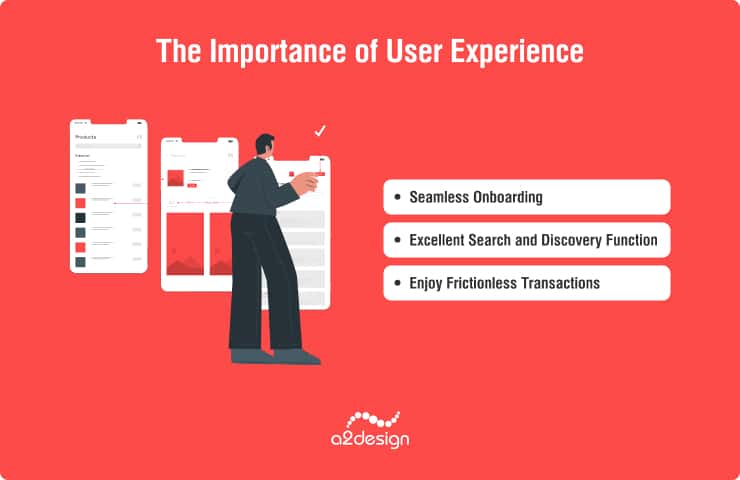
The next group of strategies is focused on those related to user experience, including:
Strategy 9: Seamless Onboarding
Picture someone walking into a store for the first time. If it’s a confusing mess and they can’t find what they need, they’re going to turn around and walk right out. Your marketplace needs to be the opposite! Every step from sign-up to that first successful sale needs to feel effortless.
Here’s how to make it work:
- Super Simple Signup: Don’t ask new users for a million details upfront. Get the bare minimum you need for them to create an account and start looking around. You can always let them fill out a more complete profile later!
- Guided Tour: For marketplaces with different features or steps to complete, a short guided tour can be massively helpful. Don’t just dump new users on the homepage and expect them to know what to do!
- Progress Indicators: If there are multiple steps to a process (like listing an item for sale), show users where they are in that process and what’s left to do. This reduces frustration and encourages them to keep going.
- Anticipate Questions: Think about what will confuse new users and have answers ready. A clear FAQ section or easy-to-find help guides can save you from answering the same questions over and over.
How A2 Design Can Help
User onboarding is where A2 Design really shines. Their expertise in intuitive design and user experience allows them to craft onboarding processes that not only look great, but seamlessly guide users through your marketplace while minimizing any potential friction points.
Strategy 10: Excellent Search and Discovery Function
Imagine a marketplace where it’s impossible to find anything. Buyers can’t find the items they desperately want, and sellers’ listings get buried and ignored. Nightmare fuel! On the flip side, a marketplace with amazing search features is a dream come true for both sides of the equation.
Here’s how to nail it:
- Powerful Search Bar: This has to be prominent and easy to use. Don’t just let people search by item name. Include categories, keywords, maybe even filters for things like price, location, or condition.
- Think Like Your Users: How would someone actually search for items in your niche? Use those words and phrases in your category names and listing structure, so buyers can find what they need easily.
- Don’t Forget About Sellers: Sometimes, buyers don’t even know exactly what they’re looking for yet. That’s where browsing comes in! Make sure new, unique, or unusual listings have a chance for visibility, even if people aren’t directly searching for those exact words. You never know what hidden gems your users might find.
How A2 Design Can Help
Building an excellent search experience, especially for a marketplace with many different kinds of listings, requires some serious tech chops. A2 Design can create a customized search solution that’s tailored to the specific needs of your marketplace. Robust search, dynamic category filters, and a well-structured listing database – they’ve got the skills to make your marketplace easy and fun to explore.
Strategy 11: Enjoy Frictionless Transactions
Think of transactions as the final handshake of a marketplace experience. If it’s confusing, stressful, or insecure, the whole interaction is ruined. Your goal is to make the payment process so simple and secure that people don’t even really think about it! Here’s how:
- Offer Choices: People have preferences. Some like using PayPal, others prefer their credit cards, maybe you even want to offer cryptocurrency options. The more payment methods you support, the wider your reach.
- Security is KING: No one is going to give you their money if they don’t trust your marketplace. Use reputable payment gateways and make sure to clearly display any security badges or seals on your site.
- Speedy and Transparent: Make it super obvious when a payment has gone through. Avoid delays at all costs, especially for sellers who want their money quickly. Keep users in the loop with clear status updates. No one likes to be left in the dark wondering what happened to their hard-earned cash.
- Test, Test, Test! Before you launch, test every possible type of transaction. Do refunds work? What about unusual scenarios? Ironing out these issues early on will save you tons of headaches later.
How A2 Design Can Help
Payment stuff can get complicated! A2 Design has tons of experience integrating various payment gateways and systems into websites and marketplaces. They can ensure the payment process on your platform is not only secure and seamless, but also tailored to your specific needs and requirements to give your users the best possible experience.
Post-Launch Growth Strategies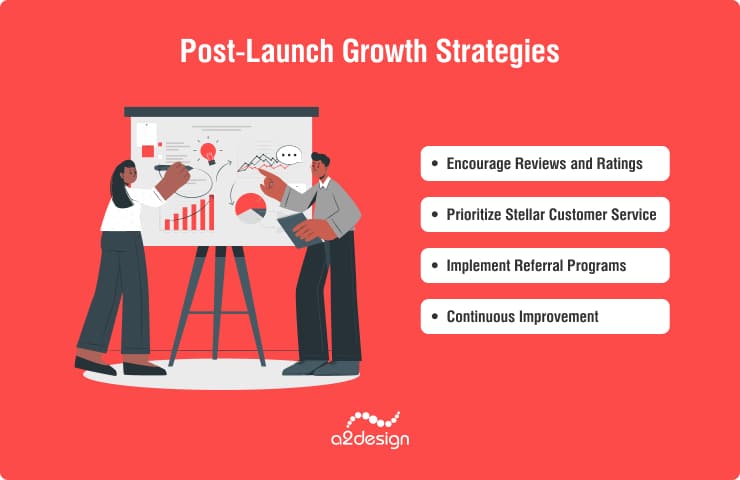
The strategies coming up are all about taking your marketplace from its exciting early stages to a truly thriving, sustainable platform. Let’s get to it.
Strategy 12: Encourage Reviews and Ratings
Think about the last time you bought something online. Did you check the reviews first? Most people do! Reviews and ratings are the lifeblood of online marketplaces. They build trust in both your platform and individual sellers, which makes people way more likely to hit that “buy” button. It’s essentially free social proof!
Here’s how to make it work:
- Make it Easy: Allow buyers to leave a quick star rating and a short review after every transaction. Don’t force them to write a long essay – even a few sentences are helpful!
- Showcase Those Stars: Display ratings prominently on listings, seller profiles, and maybe even on your marketplace homepage to highlight top-rated items and sellers.
- Address The Bad: Negative reviews are going to happen. Encourage sellers to respond promptly and politely. If possible, allow buyers a chance to edit their review after an issue is resolved. This shows you take customer satisfaction seriously.
- Gamify It: Can you turn reviews into a game? Maybe top reviewers get special badges or even discounts each month. This encourages participation and adds a fun element.
Strategy 13: Prioritize Stellar Customer Service
Treat your marketplace users like the VIPs they are! Amazing customer service builds loyalty, leads to great word-of-mouth recommendations, and can even smooth over the occasional bad experience. Here’s how to make it a top priority:
- Be There When They Need You: Make it super easy for users to contact you. Offer several options: live chat, email forms, a contact number or whatever makes sense for your marketplace.
- Speedy Replies: No one likes being left hanging. Set expectations (like promising a response within 24 hours) and then stick to them. Even if you don’t have a solution yet, acknowledge their message and give them a timeline for when they can expect a follow-up.
- Go the Extra Mile: Can you exceed expectations? Maybe a small refund for a minor issue or offering unexpected extra help can turn a disgruntled user into a raving fan.
- It’s Not Just About Problems: Proactive customer service is powerful. Reach out to new users to see if they have questions, offer onboarding help, or share some insider tips. This builds a positive relationship from day one.
Strategy 14: Implement Referral Programs
Happy users are your best marketing asset. A referral program turns them into a powerful word-of-mouth machine by giving them a reason to spread the love about your marketplace.
Here’s the basic idea: you offer your existing users some kind of reward when they successfully refer a friend who signs up, makes a purchase, or meets some other criteria. The new user also gets a reward as an extra incentive to try your platform out. It’s a win-win-win.
Here’s how to make it awesome:
- The Rewards Matter: Discounts, store credit, freebies…think about what your users would actually find valuable. The better the reward, the more motivated they’ll be to share.
- Make Sharing EASY: Give them pre-written messages, quick social media share buttons, or personalized referral codes they can easily give to friends.
- Track Your Results: Lots of tools exist to help you set up and track a referral program. Don’t just launch it and forget about it! Analyze the data so you can see what’s working and make adjustments as needed.
- Get Creative: Tiered rewards based on how many people a user refers, special bonuses for top referrers each month… don’t be afraid to experiment with gamification to make it even more fun.
Strategy 15: Continuous Improvement
The best marketplaces don’t just launch and then stay the same forever. They listen to their users, watch trends, and constantly improve to stay ahead of the curve. This is especially important early on when you’re still figuring out what works best for your specific audience and niche.
Here’s how to embrace continuous improvement:
- Feedback is Your Friend: Make it super easy for users to offer suggestions, report bugs, or just tell you what they love or hate. Surveys, feedback forms on your site, even casual social media polls can be valuable.
- Data Doesn’t Lie: Track the important stuff: sales numbers, traffic patterns, where people leave your site, etc. Tools like Google Analytics are your superpower for finding areas to improve.
- Don’t Be Afraid to Try New Things: See a cool feature on another marketplace? Test it out on yours! Is everyone in your niche suddenly talking about a new trend? See how you can capitalize on it!
- Communicate With Your People: Let your users know about new features, policy changes, and that you value their feedback. This builds a sense of community and investment in your platform.
MadPaws is an online Sydney-based marketplace for pet sitters and pet owners. It started as an MVP. Then it raised $5 million of investments through Series A funding from investors, including Qantas and Airtasker CEO Tim Fung. In 2021 the startup went on IPO with a valuation of $32 million.
The marketplace offers a wide range of services. It provides the possibility for pet owners to find pet sitters and for pet sitters to find local jobs.
ConclusionBuilding a thriving marketplace from scratch is no easy task. But, with the right approach, it’s definitely achievable. Remember these key strategies as you embark on your own marketplace journey:
- Know Your People: The better you understand your ideal users, the better you can build a marketplace they’ll truly love.
- Start Niche, Expand Smartly: Focusing on a specific market segment, especially in the beginning, lets you gain traction and build a strong foundation for future growth.
- First Impressions Matter: Make onboarding seamless, search intuitive, and transactions effortless to keep users coming back for more.
- Happy Customers = Success: Stellar customer service and a focus on building trust lead to loyal users and positive word-of-mouth.
- Never Stop Improving: Collect feedback, analyze data, and don’t be afraid to adapt and evolve your marketplace over time.
Ready to Take Your Marketplace to the Next Level?
Creating a marketplace that stands out in a crowded landscape takes more than just a great idea. That’s where A2 Design comes in. Their team of experts has the skills and experience to bring your marketplace vision to life, from user research and UI/UX design to robust development and launch support. Visit the A2 Design website to learn more about their marketplace solutions and get started on creating something amazing.
How to Build Online Marketplace MVP?

- 10 Things to Know Before Building a C2C Marketplace
- 6 Steps to start your eCommerce Marketplace
- How to Build a Website Like eBay: A Complete Development Guide
- How to Build Online Marketplace MVP?
- How to Create a Multi-Vendor Marketplace Website: A Comprehensive Guide
- How to Make a Website Like Etsy: Cost, Features, and More
